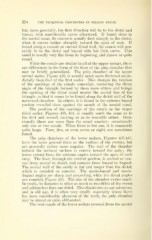Page 720 - My FlipBook
P. 720
374 THE TECHNICAL PROCEDURES IN FILLING TEETH.
but, more generallj', the first direction will be to the distal and
buccal, with considerable curve afterward. If found close to
the mesial canal, its course is usually first sharply to the distal,
when it curves rather abruptly toward the apex of root. If
found along a smooth or curved distal wall, the course will gen-
erally be to the distal and buccal with but little curve. This
canal is usually verj^ fine from its beginning, and almost or quite
round.
While the canals are similar in all of the upper molars, there
are ditferences in the form of the floor of the pulp chamber that
may be briefly generalized. The pulp chamber of the ujjper
second molar. Figure 428, is usually much more flattened mesio-
distally than that of the first molar. This changes the relation
of the openings of the canals somewhat, rendering the distal
angle of the triangle formed by them more obtuse and brings
the opening of the distal canal nearer the mesial line of the
triangle, so that it seems to be found along the distal wall of the
narrowed chamber. In others, it is found in the extreme buccal
portion crowded close against the mouth of the mesial canal.
The position of the openings of the canals in the upper
third molar, Figures 430, 431, is usually much the same as in
the first and second, varying so as to resemble either. Occa-
sionally there are more than the usual number; occasionally
only one or two canals. When there is but one. it is commonlj^
quite large. Four, five, or even seven or eight, are sometimes
foimd.
The pulp chamljers of the lower molars. Figures 432-442,
have the same general form as the surface of the crowns, but
are generally rather more angular. The wall of the chamber
toward the occlusal surface is convex toward the pulp; the
horns extend from the extreme angles toward the apex of each
cusp. The floor, through the central portion, is arched or con-
vex from mesial to distal, and concave from buccal to lingual.
The mesial wall of the cavity is flat and longer than the distal,
which is rounded or concave. The mesio-buccal and mesio-
lingual angles are sharp and projecting, while the distal angles
are rounded, Figure 435. The size of the chamber varies much.
In youth, its diameter is often as much as two-fifths of the crown
and seldom less than one-third. This diminishes as age advances,
and in old age, it is often very small ; especially where there
has been considerable abrasion of the teeth, the pulp chamber
may be almost or quite obliterated.
The root canals of the lower molars proceed from the mesial


